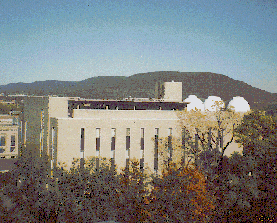Davey Lab 24" Teaching Telescope
Preparing for Your Observations

Davey Lab 24" Teaching TelescopePreparing for Your Observations |

|
I. S/N and observing time calculations
II. Calibration data
III. Observing techniques
Appendix 1: Telescope Characteristics
Appendix 2: CCD Camera and Filter Characteristics
Appendix 3: Telescope Limitations
Now all that you need to know are values for the parameters listed
above. Appendices 1 and 2 contains values for AT, e, Rn, and
P respectively. Note that in general e is wavelength dependent. It is
conventient to think of fs and fb in terms of
magnitudes. At this time, however, the sky brightness in down-town
State College is unknown. One this, however, if for sure: The sky is
MUCH brighter in the blue when the moon is up.
By the way, there are several regimes in which the above equation
simplifies. This can be very handy for quick scaling to other setups.
Just to get stared, you can estimate exposure times to reach a given
S/N in any regime using the fortran (f77) program expose.f. After compiling the source code (in
Unix) with the command:
I. S/N and Observing Time Calculations
(See also Appendices 1 and 2)
How long will you need to expose in order to get sufficient
signal? If you are looking at a very bright source, you will not
have to be very concerned with this issue, but otherwise you will want
to calculate the observing time (t) to a given signal-to-noise (S/N) given
the following observing parameters:
In this case, where t is the exposure time in seconds,
fb = background flux incident on telescope (photons/s-cm2-arcsec2)
A = aperture used for measuring fs (arcsec2)
AT = telescope aperture (cm2)
e = effeciency of telescope * instrument * detector (a fraction)
Rn = read-noise (rms) in electrons per pixel of your detector
p = plate scale of detector (arcsec/pix)
This equation can be inverted to solve (quadratically) for the
exposure time, t, in terms of all of the other parameters, including
S/N.
It is currently left as an excercise for the reader to derive the simplified
versions of the above equation in these limiting cases.
- background-limited regime: fs << fb and fb A
AT t e >> A (Rn/p)2
- readnoise-limited regime: A (Rn/p)2 >=
(fs + fb A) AT t e
where expose.param is a parameter input
file, of which here are two examples:
NOTE that expose.f uses two input lists, one for the detector quantum efficiency and the second for the sky brightness, each listing values for each broad band U, V, R, I . In the example parameter file, thes are called qe.TEK24 and sky.SC, respectively. These currently contain VERY rough guesses for the detector QE and sky brightness. The column headed 't(rn)[sec]' gives the time to reach background or source limit on a given exposure. In general, your exposures should be several times this value, all else being equal (e.g. if guiding/tracking is not an issue). The column headed 't(snr)[sec]' gives the total time to reach the specified S/N.
dome flats - needed for all data, with a few exceptions.
flux calibration - do you need to know a magnitude or just a difference in magnitudes? If the former, then you need to observe standard stars. If the latter, and you are doing time-series analysis (e.g. the light curve of a variable star), you will need to at least monitor the apparent flux of an intrinsically non-varying source.
references for standard stars - for most purposes it will be sufficient to use the UBRI standard stars listed in the Ephemeris in the telescope dome. You will find that you will need to use the fainter stars in this list or else the CCD images of the stars will be saturated (make sure you check for this). You do not want exposure times shorter than a few seconds in order that exposure times are long compared to the time it takes to open and close the shutter.
Other things to consider:
THE FOLLOWING INFORMATION IS A WAG AND WILL BE UPDATED.
In fact, you will help measure these quantities:
broad band : B, V, R, I
narrow band :
| central wavelength | width |
| [OIII] 5007 A | 61 A FWHM |
| H-alpha 6563 A | 8.5 A FWHMH |
| H-alpha 6563 A | 70.0 A FWHM |
| [N II] 6548 A | 123 A FWHM |
Here are some specific problems and solutions: